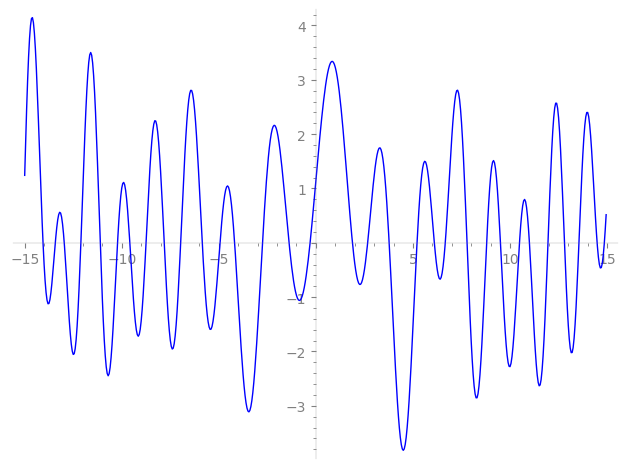| L(s) = 1 | + (7.05 − 12.2i)5-s + (−2.66 − 18.3i)7-s + (−14.4 + 8.36i)11-s − 21.2i·13-s + (−38.7 − 67.1i)17-s + (−1.43 − 0.826i)19-s + (−35.6 − 20.5i)23-s + (−37.1 − 64.3i)25-s − 100. i·29-s + (−45.9 + 26.5i)31-s + (−242. − 96.7i)35-s + (−101. + 176. i)37-s + 347.·41-s − 113.·43-s + (−45.7 + 79.2i)47-s + ⋯ |
| L(s) = 1 | + (0.631 − 1.09i)5-s + (−0.144 − 0.989i)7-s + (−0.396 + 0.229i)11-s − 0.454i·13-s + (−0.553 − 0.958i)17-s + (−0.0172 − 0.00998i)19-s + (−0.323 − 0.186i)23-s + (−0.297 − 0.514i)25-s − 0.645i·29-s + (−0.265 + 0.153i)31-s + (−1.17 − 0.467i)35-s + (−0.452 + 0.783i)37-s + 1.32·41-s − 0.402·43-s + (−0.141 + 0.245i)47-s + ⋯ |
\[\begin{aligned}\Lambda(s)=\mathstrut & 756 ^{s/2} \, \Gamma_{\C}(s) \, L(s)\cr =\mathstrut & (-0.999 + 0.0178i)\, \overline{\Lambda}(4-s) \end{aligned}\]
\[\begin{aligned}\Lambda(s)=\mathstrut & 756 ^{s/2} \, \Gamma_{\C}(s+3/2) \, L(s)\cr =\mathstrut & (-0.999 + 0.0178i)\, \overline{\Lambda}(1-s) \end{aligned}\]
Particular Values
| \(L(2)\) |
\(\approx\) |
\(1.148657309\) |
| \(L(\frac12)\) |
\(\approx\) |
\(1.148657309\) |
| \(L(\frac{5}{2})\) |
|
not available |
| \(L(1)\) |
|
not available |
\(L(s) = \displaystyle \prod_{p} F_p(p^{-s})^{-1} \)
| $p$ | $F_p(T)$ |
|---|
| bad | 2 | \( 1 \) |
| 3 | \( 1 \) |
| 7 | \( 1 + (2.66 + 18.3i)T \) |
| good | 5 | \( 1 + (-7.05 + 12.2i)T + (-62.5 - 108. i)T^{2} \) |
| 11 | \( 1 + (14.4 - 8.36i)T + (665.5 - 1.15e3i)T^{2} \) |
| 13 | \( 1 + 21.2iT - 2.19e3T^{2} \) |
| 17 | \( 1 + (38.7 + 67.1i)T + (-2.45e3 + 4.25e3i)T^{2} \) |
| 19 | \( 1 + (1.43 + 0.826i)T + (3.42e3 + 5.94e3i)T^{2} \) |
| 23 | \( 1 + (35.6 + 20.5i)T + (6.08e3 + 1.05e4i)T^{2} \) |
| 29 | \( 1 + 100. iT - 2.43e4T^{2} \) |
| 31 | \( 1 + (45.9 - 26.5i)T + (1.48e4 - 2.57e4i)T^{2} \) |
| 37 | \( 1 + (101. - 176. i)T + (-2.53e4 - 4.38e4i)T^{2} \) |
| 41 | \( 1 - 347.T + 6.89e4T^{2} \) |
| 43 | \( 1 + 113.T + 7.95e4T^{2} \) |
| 47 | \( 1 + (45.7 - 79.2i)T + (-5.19e4 - 8.99e4i)T^{2} \) |
| 53 | \( 1 + (22.2 - 12.8i)T + (7.44e4 - 1.28e5i)T^{2} \) |
| 59 | \( 1 + (-450. - 781. i)T + (-1.02e5 + 1.77e5i)T^{2} \) |
| 61 | \( 1 + (402. + 232. i)T + (1.13e5 + 1.96e5i)T^{2} \) |
| 67 | \( 1 + (173. + 300. i)T + (-1.50e5 + 2.60e5i)T^{2} \) |
| 71 | \( 1 - 620. iT - 3.57e5T^{2} \) |
| 73 | \( 1 + (564. - 326. i)T + (1.94e5 - 3.36e5i)T^{2} \) |
| 79 | \( 1 + (-68.3 + 118. i)T + (-2.46e5 - 4.26e5i)T^{2} \) |
| 83 | \( 1 - 298.T + 5.71e5T^{2} \) |
| 89 | \( 1 + (-422. + 732. i)T + (-3.52e5 - 6.10e5i)T^{2} \) |
| 97 | \( 1 + 494. iT - 9.12e5T^{2} \) |
| show more | |
| show less | |
\(L(s) = \displaystyle\prod_p \ \prod_{j=1}^{2} (1 - \alpha_{j,p}\, p^{-s})^{-1}\)
Imaginary part of the first few zeros on the critical line
−9.584348712071983437168312660108, −8.749630144373137985364385897253, −7.81328005433913695146575989207, −6.96610005051950479969304929338, −5.85392510425481811039978014488, −4.93848078806656426013815156718, −4.18741632914210145586582958471, −2.75080373007396616856289703838, −1.38271176782227245668620498326, −0.29921776641251474261957497415,
1.88260850012461048774750058184, 2.66579071355549317393076311147, 3.77274553554503689916659467813, 5.20883398848806543763339386719, 6.10055508805653352924750728488, 6.66268612043090363912832847479, 7.78450428150014216383800607046, 8.794709508328777152217892924291, 9.505388907211888475850100770755, 10.48594159801605627177622292089

